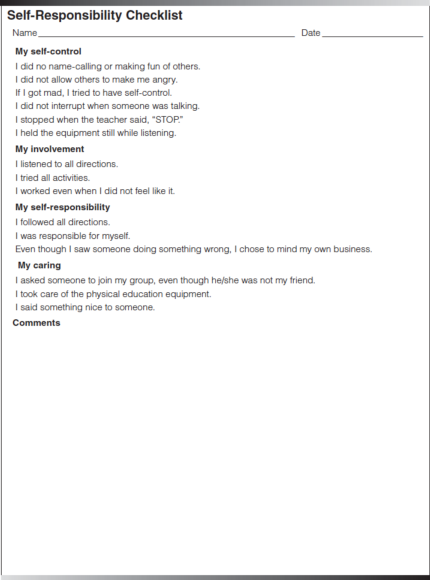Teaching Personal and Social Responsibility
This is an excerpt from Performance-Based Assessment for Middle and High School Physical Education-3rd Edition by Jacalyn Lea Lund,Mary Fortman Kirk.
The Teaching Personal and Social Responsibility (TPSR) IM was developed by Don Hellison in response to the needs of inner-city children who were at great risk for incarceration. Character development has long been a part of physical education. When Clark Hetherington first published his four tenets of physical education in 1910, character was one of those elements. At that time, the battle of the systems was occurring between those who thought physical education should promote an “of the physical” approach and others who wanted a “through the physical” approach. Those favoring the “of the physical” approach felt that the purpose of physical education was to develop fitness in individuals. The other camp felt that individuals could develop psychomotor and cognitive-domain learning, fitness, and good moral character through sports and other types of physical activity such as dance and gymnastics. In a sense, the “through the physical” approach is like the philosophy behind Hellison's TPSR model.
While teaching sport and games, Hellison promoted the development of character simultaneously with psychomotor and cognitive instruction. Instead of waiting for the teachable moment to talk about character development, teachers using TPSR design lessons to help move students up a hierarchy, starting with respect and caring for others in the gymnasium to displaying respect for others in all areas of life and being a role model for others. In the TPSR IM, an assumption is made that responsibility to self and others can be taught (Metzler 2011). Lessons in the TPSR IM are designed to be student-centered and to allow students to make decisions. Teachers build in opportunities for student choice and decision making and gradually offer more independence to students. Psychomotor and cognitive learning are not separate from social and personal responsibility, but rather, the three are woven together. Hellison (2011) developed a hierarchy of responsibility that had five levels:
Level 1: Respecting the rights and feelings of others
Level 2: Participation and effort
Level 3: Self-direction
Level 4: Helping others and displaying leadership
Level 5: Demonstrating responsibility outside the gym
Students do not automatically start at level 1. Some students have lessons to learn prior to reaching this level. Additionally, not all students in a class are at the same level of responsibility. Teachers must determine this level for students and then create learning situations that allow them to move up the hierarchy starting from their own personal level. In TPSR, affective-domain learning is not necessarily linear; sometime students will move down depending on things that are happening at school or at home (Metzler 2011). However, with lessons that target growth of personal and social responsibility, change is possible. Reflection about choices made is also part of the learning in that students are encouraged to see the benefits of making responsible choices (Metzler 2011).
According to Parker and Stiehl (2015), the focus of level 1 is on self-control and personal responsibility. Students should demonstrate the ability to get along with others. Students functioning at level 2 demonstrate effort by being self-motivated to participate in activity, and display willingness to try new activities and continue to participate even when they would like to give up. At level 3, students are self-directed and capable of working independently. They also set personal goals for achievement and resist peer pressure. When students reach level 4, they show leadership and want to help others. They want to contribute to the well-being of others and demonstrate care, compassion, and empathy. While the first four levels are set in the gymnasium, students at level 5 will demonstrate the qualities of the other four levels in other parts of the school, their homes, and their communities.
Although the emphasis of TPSR is given to the affective domain, learning is expected in all three domains. Assessments for the psychomotor and cognitive domains used for other IMs are also used with TPSR. In keeping with the intent of the IM, teachers might provide a menu of options and let students decide how they will demonstrate competence for the unit. Affective-domain learning is dependent on the teacher's observations of student behaviors and lesson outcomes to promote affective-domain growth. Journal entries are excellent ways for teachers to assess student growth on the TPSR hierarchy and to note where students are through their reflections. Using these reflections, teachers develop ways to create opportunities for growth in future physical education lessons. The checklist in figure 7.11 is a self-reflection of student responsibility. If teachers are using a similar checklist, students should also write a reflection giving examples from the day's class of how they functioned at their identified level. A responsibility cube with different elements of the levels could provide a prompt for an exit slip reflection or a journal entry.
Despite looking rather simplistic, the TPSR IM is very complex. Readers are encouraged to read Hellison's (2011) explanation of the model and suggestions for implementing it during instruction. As with the other models in this chapter, Metzler (2011) also provides several suggestions for using this model.

Figure 7.11  checklist that can be used when using the TPSR instructional model.
More Excerpts From Performance-Based Assessment for Middle and High School Physical Education-3rd EditionSHOP

Get the latest insights with regular newsletters, plus periodic product information and special insider offers.
JOIN NOW
Latest Posts
- Using double inclinometers to assess cervical flexion
- Trunk flexion manual muscle testing
- Using a goniometer to assess shoulder horizontal adduction
- Assessing shoulder flexion with manual muscle testing
- Sample mental health lesson plan of a skills-based approach
- Sample assessment worksheet for the skill of accessing valid and reliable resources


